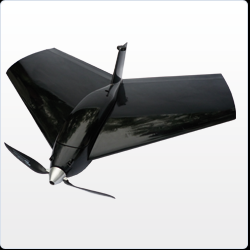This article is more than 1 year old
French offer gunshot-locator flying robots
Next: Droids which can pry open cold dead hands
Paris Airshow There are lots of small, hand-launched roboplanes around these days, usually intended to let foot soldiers get an idea what lies over the hill or around the corner. There are also lots of acoustic gunshot spotter rigs nowadays, some of them very fancy indeed.

Shooting at the robots. Bad idea.
Neither of these on their own would be news, but French company Secapem claims to be the first to combine the two, offering a small, portable unmanned plane which flies about and detects the tracks of bullets fired at it. At the moment the system works mainly as a way for the plane's operator to evade hostile fire, but the developers believe that in future the kit will be able to mark the locations of enemy gunmen on a digital map.
Secapem MD Emmanuel Pasqualini described the system to the Reg yesterday at the Paris Airshow, underway at Le Bourget. His company's special sauce is its unobtrusive, 30g skin sensors, of which at least three must be fitted to an aircraft. The sensors pick up the distinctive conical shockwave - the sonic boom - which trails behind bullets or projectiles flying faster than sound. (Subsonic rounds are normally fired only from pistols and submachineguns, and aren't much of a threat on modern battlefields.)
A central processor can then work out the bullets' track. At the moment, it does so relative to the aircraft only - it can be used as a threat warning for the operator, or for the pilot in the case of larger manned aircraft. But Pasqualini says that if it were integrated with location systems - GPS satnav, perhaps augmented by inertial reckoning - it could accurately locate the firing weapon on a map.
"We need to work more with the autopilot systems," he says.
According to Pasqualini, the Acoustic Hostile Fire Indicator (A-HFI) isn't bothered by a noisy environment - it doesn't need to be mounted on a quiet electric UAV - and it isn't dependent on detecting the muzzle blast of the firing weapon. This is the great Achilles heel of many shot-spotter systems, as the distinctive sonic crack is easily distinguished but the actual gunshot is easily confused with echoes or other guns.
Secapem's system is in its infancy, plainly, but it's developed from established kit: the firm formerly applied this tech in towed targets used to train pilots in air-to-air gunnery. It's hard to say whether this acoustic route is more or less valuable than the new infrared rivals nearing the market. However, Thales' Elix-IR reportedly weighs 30kg; A-HFI, at 30g a sensor and 73g for the processing board, may have the small UAV sector to itself. ®
